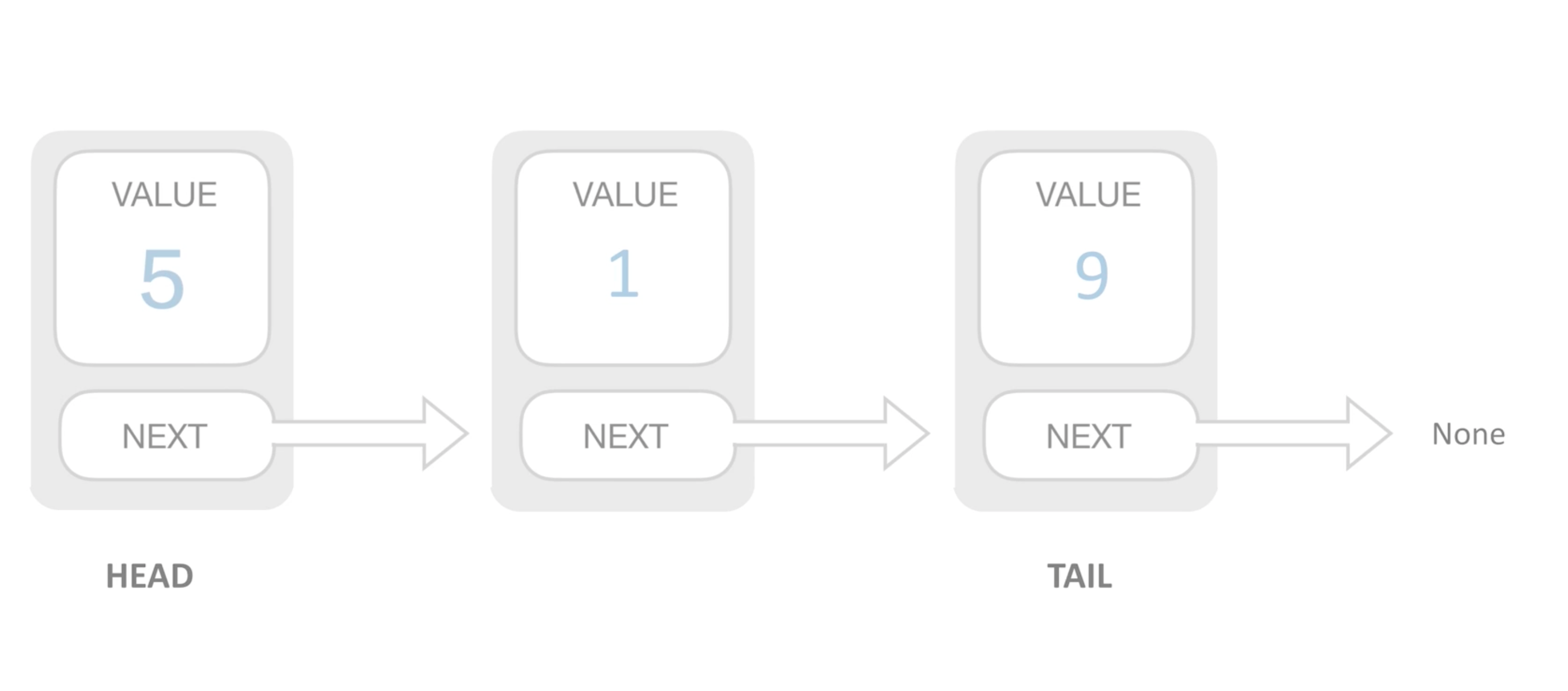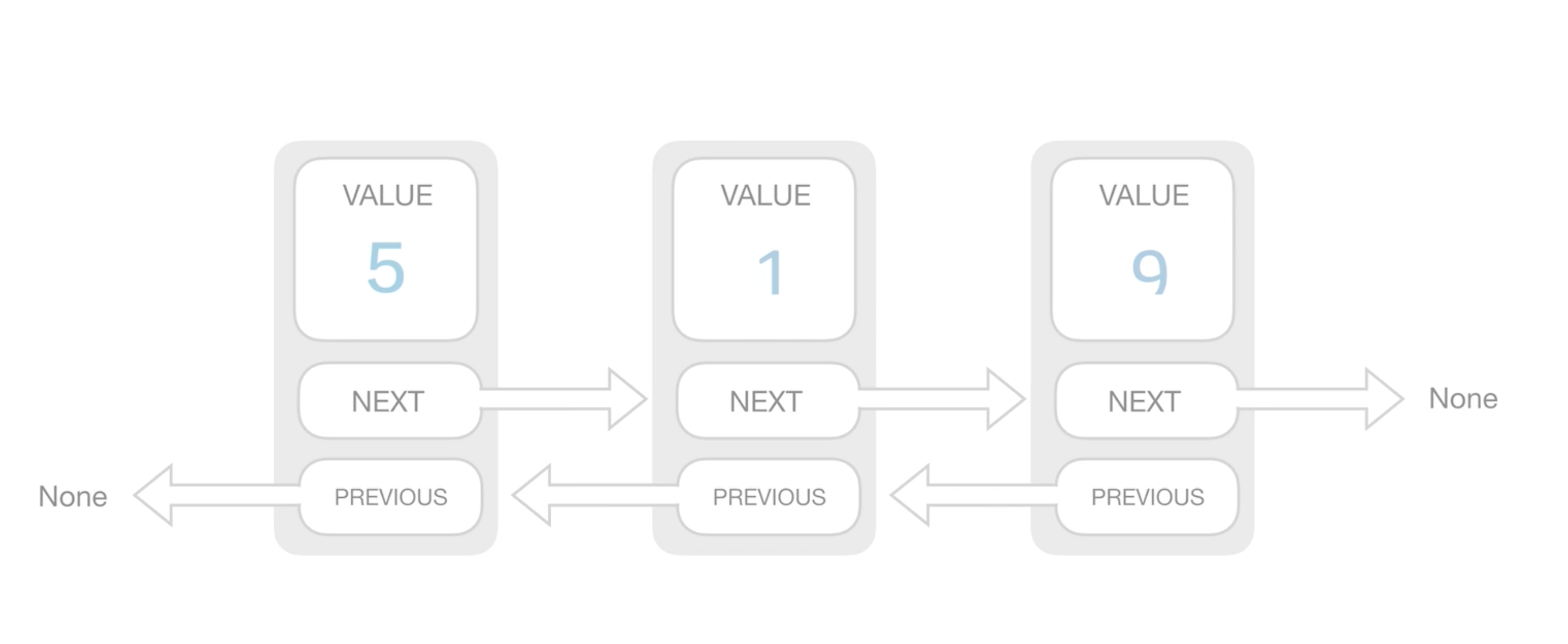链表
单链表
 双向链表
双向链表

特点
- 插入和删除,时间复杂度O(1)
- 查找,时间复杂度平均O(n)
应用场景
- 改善插入删除时间复杂度
- 不知道有多少元素,当有新元素就插入到末尾
实例
反转链表
input : 1->2->3->4->5->NULL
output : 5->4->3->2->1->NULL
双指针迭代
public static ListNode reverseList(ListNode head) {
ListNode cur = head;
ListNode pre = null;
while (cur != null) {
//记录当前节点的下一个节点
ListNode temp = cur.next;
//然后将当前节点指向pre
cur.next = pre;
//pre和cur节点都前进一位
pre = cur;
cur = temp;
}
return pre;
}
双指针较简单,且容易理解
递归
递归较难一些,详细理解看注释。
public static ListNode reverseList(ListNode head) {
//递归终止条件是当前为空,或者下一个节点为空
if (head == null || head.next == null) {
return head;
}
//这里的cur就是最后一个节点
ListNode cur = reverseList(head.next);
//这里请配合动画演示理解
//如果链表是 1->2->3->4->5,那么此时的cur就是5
//而head是4,head的下一个是5,下下一个是空
//所以head.next.next 就是5->4
head.next.next = head;
//防止链表循环,需要将head.next设置为空
head.next = null;
//每层递归函数都返回cur,也就是最后一个节点
return cur;
}
两两交换链表中的节点
input : 1->2->3->4->5->NULL
output : 2->1->4->3->1->NULL
使用stack实现
public static ListNode swapPairs(ListNode head) {
//过滤掉不用转换的逻辑
if (head == null || head.next == null) {
return head;
}
//用栈存储
Stack<ListNode> stack = new Stack<>();
//创建一个特殊节点
ListNode r = new ListNode();
//将当前节点赋值head
ListNode cur = head;
//缓存下r节点,因为后面会移动r节点
head = r;
while (cur != null && cur.next != null) {
stack.add(cur);
stack.add(cur.next);
//移动两位
cur = cur.next.next;
//第一次循环时,取出2,将r.next赋值2
r.next = stack.pop();
//将r变成2
r = r.next;
//第一次循环时,取出1,将2.next赋值1
r.next = stack.pop();
//将r变成1,等待下次循环时,1指向4
r = r.next;
}
//循环完以后,如果当前节点非空,说明为奇数个数,将最后一个节点cur赋值给r.next
if (cur != null) {
r.next = cur;
} else {
r.next = null;
}
return head.next;
}
使用迭代实现
迭代实现,关键在于,第二轮指针操作,需要缓存上一轮的末尾节点,用来指向下一轮的交换后的头节点。
public static ListNode swapPairs1(ListNode head) {
if (head == null || head.next == null) {
return head;
}
ListNode p = new ListNode();
p.next = head;
ListNode a = p;
ListNode b = p;
ListNode t = p;
//因为是两两替换,b是第二个节点,如果它的下下节点都有的话,就可以实现两两替换,否则就终止
while (b != null && b.next != null && b.next.next != null) {
//先将 a指向第一个节点
a = b.next;
//再将 b指向第二个节点
b = b.next.next;
//这里比较关键,因为在2->1, 4->3 过程中,需要将1->4,
// 这样才能关联起来,这一步就是这个操作,
// 第二轮时,b是4,下面将第一轮的a缓存给t就可以
t.next = b;
// 将a节点缓存给t
t = a;
// 第一轮将1指向3
a.next = b.next;
// 第一轮将2执行1 这步骤走完,链表变成 2->1->3->4
b.next = a;
// 然后将b改为1,执行下一轮 3->4 的替换
b = a;
}
return p.next;
}
递归实现
递归的关键,在于第二轮将1->4的逻辑,让每次递归都返回head的第二个节点,这样来实现。
public static ListNode swapPairs2(ListNode head) {
if (head == null || head.next == null) return head;
// 第一次递归时,缓存temp = 2
ListNode temp = head.next;
// 该步骤是,将下次递归返回的节点赋值给本次的第一个节点,也就是将1->4
head.next = swapPairs2(temp.next);
// 第一次递归 2->1 第二次递归 4->3
temp.next = head;
// 第一次递归完返回2,第二次递归时返回4,返回4时,上面 head.next = swapPairs2(temp.next); 实现 1-> 4
return temp;
}
链表是否有环
利用Set
Set的原理其实就是元素不重复,如果有环,那么在遍历结束前,肯定能碰到相同的元素,这样来判断是否有环
public static boolean hasCycle(ListNode head){
Set<ListNode> s = new HashSet<>();
while (head!=null){
if(s.contains(head)){
return true;
}
s.add(head);
head = head.next;
}
return false;
}
利用快慢指针
public static boolean hasCycle1(ListNode head) {
if (head == null || head.next == null) return false;
ListNode fast = head.next;
ListNode slow = head;
while (fast != null && slow != null) {
if (fast == slow) return true;
fast = fast.next.next;
slow = slow.next;
}
return false;
}
总结
以上是链表中最常见的几个题型,对于这些基本的操作,一定要熟练。